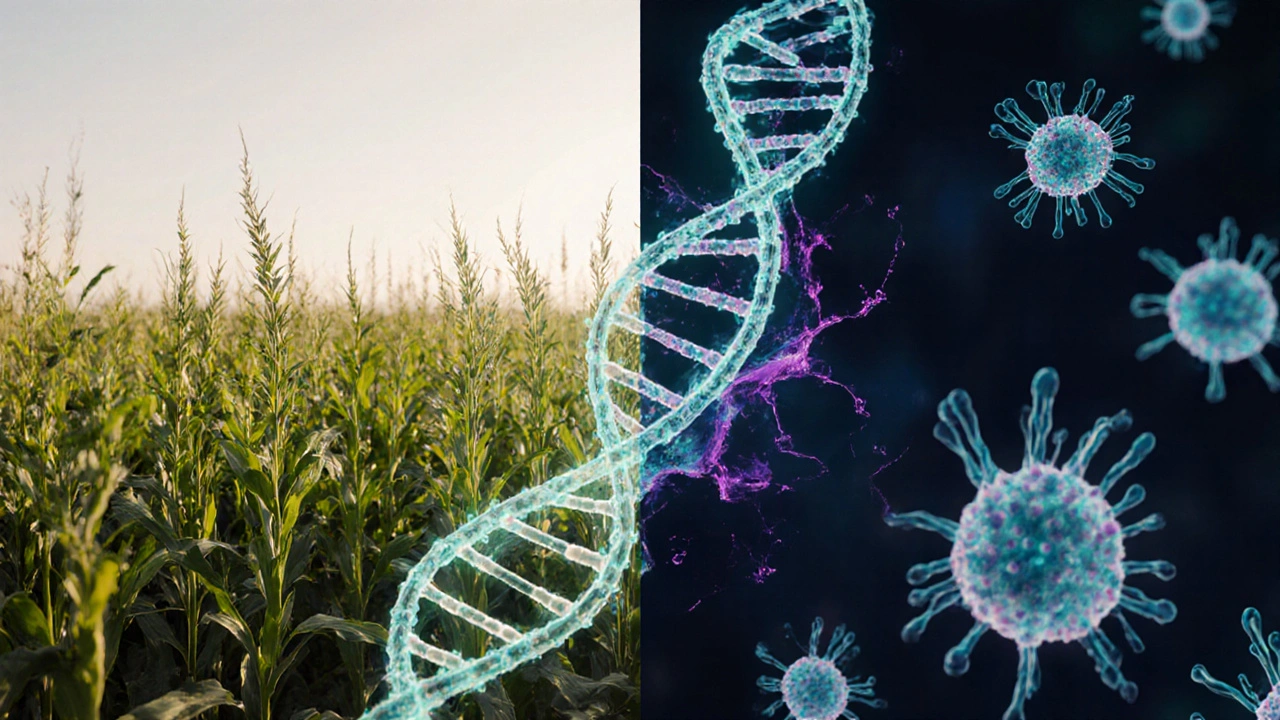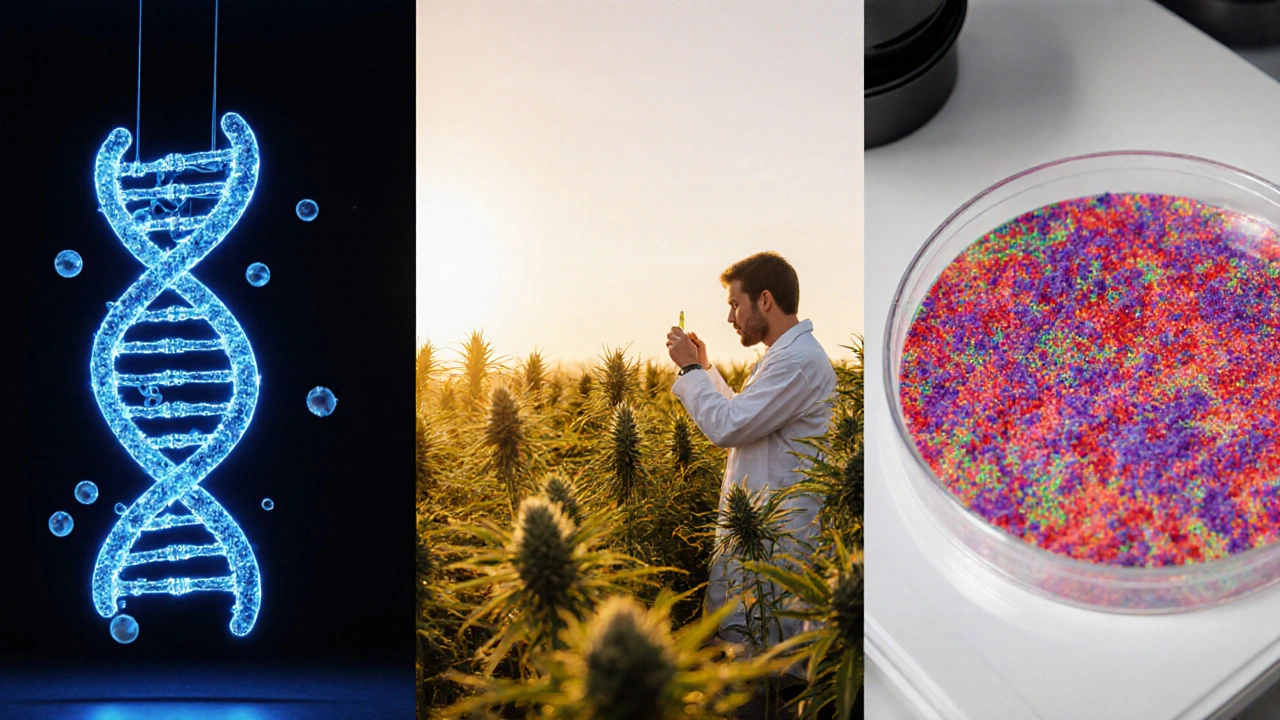Genetic Traits Explorer
What is a Trait?
A trait is an observable characteristic that results from gene activity. Examples include drought tolerance, cannabinoid profile, or disease resistance.
DNA and Genes
DNA contains the genetic information, genes are specific segments coding for proteins, and traits are the expressions of these genes.
Genetic Components Involved:
Breeding Method:
Time to Market:
Understanding genetics is key to grasping why the next generation of crops, microbes, and even medicinal plants looks so different from what came before.
What Genetics Means for Strain Development
In simple terms, Genetics is a field of biology that explains how traits are inherited from one generation to the next. When you hear the word “strain,” think of a population of organisms that share a unique set of characteristics-whether those traits improve yield, resistance to disease, or therapeutic potency.
Core Biological Building Blocks
Every strain’s identity comes down to three DNA‑based elements:
- DNA is the long‑chain molecule that stores genetic information in the form of nucleotides.
- Gene is a specific segment of DNA that codes for a particular protein or function.
- Trait is the observable characteristic-like drought tolerance or cannabinoid profile-that results from gene activity.
Connecting the dots between these pieces is what lets scientists turn a vague idea-"a strain that thrives in dry soil"-into a concrete product.

Traditional Breeding vs. Modern Genetic Tools
| Aspect | Traditional Breeding | Genome Editing (e.g., CRISPR) |
|---|---|---|
| Time to market | 5-10 years | 1-3 years |
| Precision | Low - many unwanted genes transferred | High - single‑gene edits |
| Regulatory pathway | Generally accepted | Varies by jurisdiction |
| Cost (R&D) | Moderate | Higher upfront, lower long‑term |
| Population diversity | Broad | Targeted |
Key Modern Techniques
Three technologies dominate today’s strain‑building pipelines:
- Marker‑assisted selection uses DNA markers to track desirable genes during conventional crosses, cutting down guesswork.
- Genome sequencing provides a complete read‑out of an organism’s DNA, letting researchers pinpoint every gene that matters.
- CRISPR is a precise gene‑editing tool that can insert, delete, or tweak a gene in a matter of weeks.
Each method feeds into the same workflow: identify a target trait, locate the responsible gene, and then lock that gene into the new strain.

Step‑by‑Step Workflow for Creating a New Strain
- Define the breeding goal. Clear objectives-like “increase THC15%” or “boost drought tolerance”-guide every downstream decision.
- Gather genetic information. Use Genome sequencing to map the parent lines and locate candidate genes associated with the desired trait.
- Screen with markers. Apply Marker‑assisted selection to tag seedlings that carry the right genetic variants, saving space and time.
- Edit if needed. When no natural variant exists, employ CRISPR to directly edit the gene-adding a beneficial mutation or knocking out a detrimental one.
- Field test the phenotype. Grow the edited or selected plants in real conditions and record the Phenotype-the visible expression of the genotype such as yield, oil content, or disease resistance.
- Stabilize the strain. Perform several back‑crosses or self‑pollinations to ensure the trait is reliably passed to future generations.
- Regulatory review. Prepare data packages showing the genetic changes, safety assessments, and environmental impact.
This loop repeats until the strain meets the original performance targets and passes regulatory hurdles.
Real‑World Examples
Example 1 - Disease‑Resistant Wheat: Researchers identified a gene on chromosome3B that conferred resistance to stripe rust. Using marker‑assisted selection, they introgressed the gene into a high‑yielding variety, cutting the disease‑related loss from 20% to under 2% within four breeding cycles.
Example 2 - High‑CBD Cannabis: By sequencing dozens of Cannabis sativa lines, scientists mapped the CBD synthase gene cluster. CRISPR was then used to deactivate the THC synthase gene, delivering a strain that consistently produces >15% CBD with trace THC.
Example 3 - Probiotic Yogurt Cultures: A probiotic strain of Lactobacillus was engineered with CRISPR to survive higher stomach acidity. The edited strain showed a 30% increase in colonization rates in clinical trials, translating to stronger immune support.

Challenges and Ethical Considerations
Even with powerful tools, several hurdles remain:
- Off‑target effects. CRISPR can occasionally edit unintended sites, potentially introducing new traits or health risks.
- Regulatory patchwork. Some countries treat edited strains as GMOs, while others exempt them if no foreign DNA is added.
- Public perception. Consumers may distrust strains labeled “gene‑edited,” affecting market adoption.
- Intellectual property. Patent disputes over specific genes or editing methods can limit who can use a new strain.
Balancing scientific progress with transparent safety data and clear labeling is essential for long‑term acceptance.
Future Trends
Three trends will shape the next decade of strain development:
- Machine‑learning‑guided breeding. Algorithms will predict the best gene combinations before any cross or edit takes place.
- Base editing. A newer CRISPR variant that swaps a single DNA letter without cutting the double helix, reducing off‑target risk.
- Open‑source gene libraries. Collaborative databases of verified trait‑gene links will speed discovery for smaller labs and startups.
When these tools converge, the time from concept to commercial strain could shrink to under a year for simple traits.
Frequently Asked Questions
How does marker‑assisted selection differ from traditional breeding?
Marker‑assisted selection (MAS) adds DNA markers to the breeding toolbox. Instead of waiting for a plant’s physical traits to appear, breeders test seedlings for the presence of specific genetic markers linked to the desired trait. This speeds up selection, reduces field space, and lowers the chance of carrying unwanted genes.
Is CRISPR considered a GMO?
Regulations differ worldwide. In the U.S., if CRISPR edits do not insert foreign DNA, the resulting organism may be exempt from GMO labeling. The EU, however, currently treats all gene‑edited crops as GMOs. Always check local guidelines before commercial release.
What safety tests are required for a new strain?
Typical safety assessments include: (1) toxicology studies, (2) allergenicity screening, (3) environmental impact analysis (e.g., potential gene flow), and (4) stability testing across multiple generations to confirm the trait remains consistent.
Can I use CRISPR at home to create a new plant strain?
CRISPR kits are available for educational purposes, but commercial‑grade editing requires specialized equipment, biosafety approvals, and strict record‑keeping. Home experiments are generally limited to model organisms and must comply with local bio‑regulations.
What is the difference between phenotype and genotype?
Genotype is the full set of genes an organism carries. Phenotype is the observable expression of those genes-such as height, color, or medicinal compound levels-shaped by both genetics and environment.

